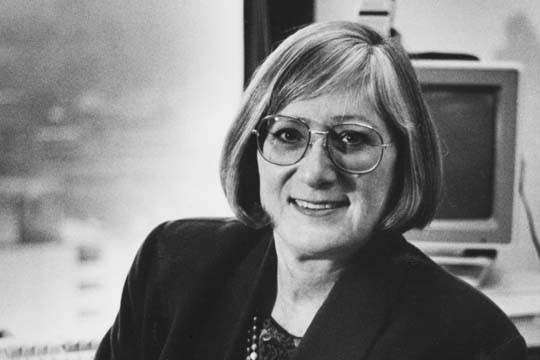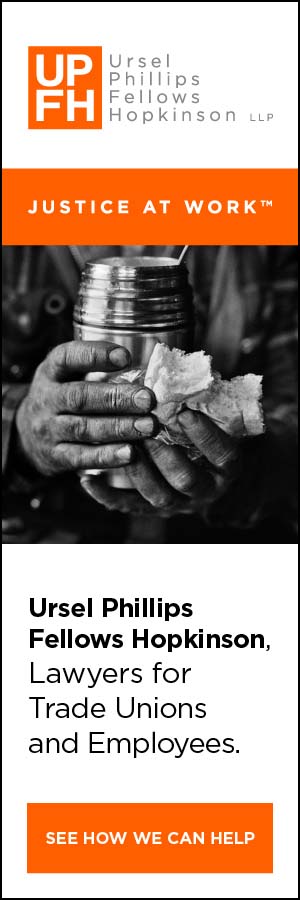
Photo: Courtesy Wsib
In April of next year, a health and safety symposium is being held in Elliot Lake, Ontario, to commemorate the 40th anniversary of the Steelworkers' wildcat strike to protest the conditions in the mines. It's truly painful that Linda will not be there. In every sense, the eventual victory on behalf of the workers was hers.
Linda joined the NDP research staff in September of 1973. She was a remarkable anchor to an equally remarkable crew of researchers who, cumulatively and in concert, were almost entirely responsible for the ascent of the Ontario NDP to official opposition status in 1975.
Several of that wondrous band of researchers are here today. Not a one of them would contest the view that Linda Jolley was the rarest of colleagues: smart, intuitive, imaginative, generous, collegial, prodigious of work habits and almost supernaturally decent. I was the beneficiary of all those traits because Linda and I worked most closely together. (And even as I wrote those words, I could hear that low-throated chuckle, expressing pleasure and intellectual skepticism in equal measure.)
Sixty-eight is far too young to die. But what a legacy she left.
ASTONISHING ACHIEVEMENTS
Let me remind you, if reminding is ever needed: From 1973 onwards, Linda made occupational health and safety the cause celebre, the centrepiece of her life. Her achievements, in retrospect, are astonishing. It all began with the patterns of disease and death that stalked the workers of Sudbury and Elliot Lake. In collaboration with the Steelworkers union, Linda, in '73 and '74, methodically assembled a dossier of political, institutional and corporate negligence that forced the hands of the Conservative government.
How well I remember it. There were splenetic debates across the floor of the legislature, all of it informed on our side by Linda, and I remember, equally well, Linda stealing into the legislative chamber, sitting under the press gallery adjacent to the rows of MPPs, giving me smiles and thumbs-up of encouragement as the debates raged on. There she sat, quiet, reserved, the model of innocence. No one would have guessed that the architect of governmental chaos was in the room.
INCREDIBLE RESEARCH
Her incredible compendium of research led directly to the creation, in September 1974, of the Royal Commission on the Health and Safety of Workers in Mines, chaired by Dr. James Ham, at the time the head of the Engineering School at the University of Toronto.
I recite this piece of history because it resulted in a stunning shift in the landscape of occupational health in Ontario.
You see, Linda never stopped with the mere formation of the Ham Commission. It simply further unleashed her insatiable, probing energy. She took on, pretty well single-handedly, the formidable job of chronicling the criminal transgressions of the corporate/political complex. She worked for weeks upon weeks, all alone, in the bowels of the Ministry of Mines at Queen's Park and similarly in the offices of the Steelworkers in Elliot Lake, putting together an impeccable analysis, based on tattered, mouldering documents that had never before been scrutinized, by anyone, of the levels of dust exposure that caused silicosis,and the exposure to "radon daughters," as they're called, in the uranium mines, leading to lung
cancer.
I went back this week to re-read parts of the Ham Commission report and some of the news coverage, and was reminded of what can only be called a tour de force on Linda's part. She looked at the dust levels, covering 16 years in 17 different mines and established, irrefutably, that not once in that entire period had the levels of exposure conformed to the designated limits. She then did the same with radiation levels in the mining of uranium, with the same findings.
Tenacity has never had a finer exponent. By sheer coincidence, just last week I was visiting with Lynn Williams. He's now 90 years old and in a nursing home, but as sharp and acute as ever. Lynn was, as many here will know, the director of District 6 of the Steelworkers during the 1970s. I told him of Linda's death and he expressed heartfelt sadness. Lynn himself had been totally absorbed in the battles of the Elliot Lake miners, and I thought, as we talked, of another aspect of Linda's life, largely unknown and unacknowledged.
FRIENDSHIPS FORGED
The work she did in those memorable days was intensely respectful of the trade union movement and its representatives who were dealing with the human fallout of this avalanche of disease. She forged enduring friendships at the grassroots, at the local level, that had a lasting and positive impact on the relationships between the trade unions and the New Democratic Party. They were relationships sealed by issues rather than personalities, and so they were binding. And the NDP benefitted for years to come.
So you see, at every turn, Linda's presence was indispensable. And in the case of the commission, Dr. Ham was completely boxed in. Based entirely on Linda's research, I appeared before the commission in February 1975 and laid out the unanswerable indictment of the government, the companies, and institutions like the Workmen's Compensation Board (as it was then called) in their ruthless complicity in the illness and death of hundreds upon hundreds of miners in Sudbury and Elliot Lake.
And that's what lies at the heart of Linda's legacy. The Ham Commission reported in June of 1976. Ingrained in the report were the principles of the right to know, the right to participate and the right to refuse unsafe work, all of which were rights previously denied the workers and their unions. And then there followed, in 1978, the Occupational Health and Safety Act of Ontario: a massive breakthrough for working people.
Linda Jolley had reinvented the class struggle, and the workers won.
LINDA SAVED LIVES
When you pause to think of it for a moment, Linda saved lives, countless lives. There was never a whisper of self-aggrandizement; she never sought the spotlight, it was nowhere to be found in her persona. She just took enormous pleasure in the vital work of social democracy and the contribution she was able to make. And she made it with such focus, zest and determination.
That contribution never ended. The mines were not her only target: she did the same with asbestos exposure, and mercury poisoning, and the entire panoply of carcinogens in the workplace. And, of course, as we've heard, it was inevitable and just that her life would then encompass leadership roles in her chosen field, from the Ontario Federation of Labour to the Workplace Safety and Insurance Board.
We will truly miss her. I must admit that I saw little of Linda after politics. Our lives diverged as lives so often do. But we met at odd conferences over the years, and whenever I've had a speech to make that touched on occupational health, I always called Linda for the up-to-date installments of what should be said, and I always faithfully said it. And it was never wrong.
She was so fair and so kind and so honest. Such a wonderful friend to all of us. And she had so much left to give and to do. Life can be damnably unfair. But in that one all-too-short lifetime, Linda Jolley made a huge, dramatic improvement to the human condition. Working people will forever reap the benefits. Of how many can that be said?
Good-bye, Linda. Yours is a life to celebrate.
This eulogy was given by Stephen Lewis on October 17, 2013. It is published in Our Times with permission, as part of the magazine's intermittent "Passing the Torch" series of articles remembering those who have gone before us in the struggle for a better world. Linda Jolley passed away on September 24, 2013. She was research director for Stephen Lewis in the 1970s. Her dedication to workers' health and safety led her to become director of health and safety for the Ontario Federation of Labour, and subsequently a vice-president of Ontario's Workplace Safety and Insurance Board
Stephen Lewis is a celebrated humanitarian and a beloved speaker and activist for social justice. Among many other things, he was leader of the Ontario New Democratic Party (1970 to 1978), Canada's ambassador to the United Nations (1984-1988), and the UN's Special Envoy for HIV/AIDS in Africa (see his book Race Against Time).










